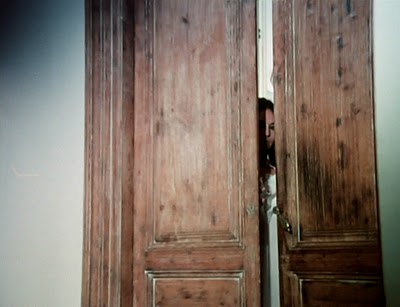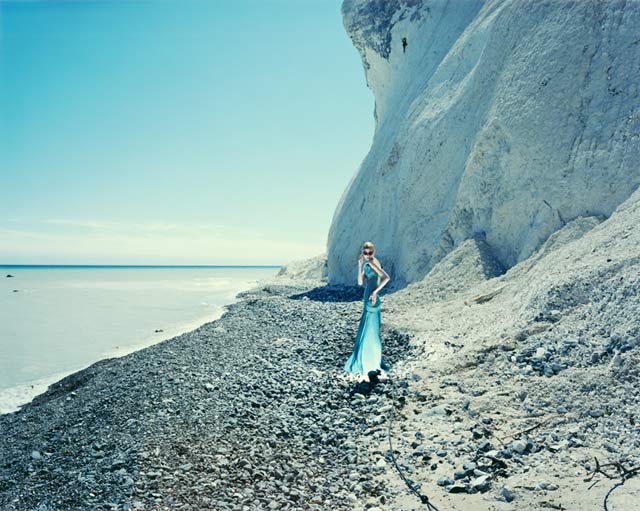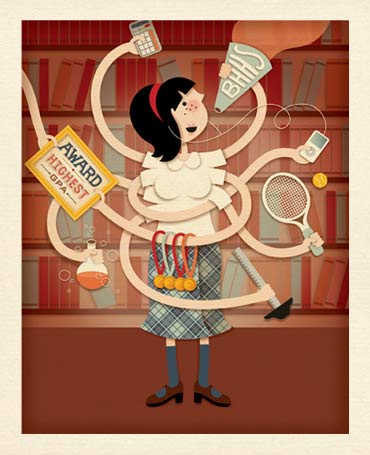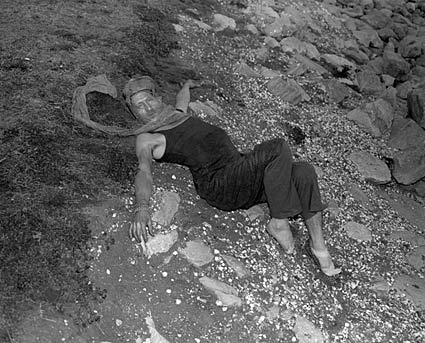pipeline

When people are anxious they release a chemical signal that’s detectable on a subconscious level by those close to them. That’s the implication of a new study that collected sweat from people as they completed a high-rope obstacle course, and then tested the effect of that sweat on study participants as they played a gambling game.
Katrin Haegler’s team placed the sweat samples inside odourless tea bags which were attached with an elastic band to the underside of the gambling participants’ noses. For comparison, the participants were also exposed to sweat collected from non-anxious riders of an exercise bike.
When exposed to the anxious sweat, the participants took longer to decide over, but were more likely to bet on the highest risk scenarios. (…) In other words, the detection of another person’s anxiety made them more willing to take risks. Quite why this should be remains unclear.
{ BPS | Continue reading }
photo { Gary Lee Boas }
mystery and paranormal, olfaction, psychology | November 28th, 2010 12:05 pm
giraffe, marketing, video | November 26th, 2010 4:36 pm
haha, housing, video, visual design | November 26th, 2010 4:22 pm

Light is special. In our everyday experience it behaves like a wave, which gets reflected, refracted and shows interference with other light of the same wavelength.
At the same time, light also consists of particles, so-called photons.
This duality is quite fundamental: the Hanbury Brown and Twiss experiment for example only works because of the particle-like properties of light.
This amazing and perhaps confusing duality, where light in one experiment appears to be a wave and in others it behaves like particles, is now laid bare in a paper published in Nature.
There, Jan Klaers, Martin Weitz and colleagues from the University of Bonn in Germany take one of the classical properties of light waves and turn it upside down — by demonstrating a related effect that only works when considering the particle qualities of light.
{ Joerg Heber | Continue reading }
photo { Valerie Chiang }
mystery and paranormal, science | November 24th, 2010 6:14 pm

Having failed to construct a firebreak in Greece, the Europeans are hoping that they can stop the euro crisis in Ireland. But, even as an Irish rescue package is put together, the bond markets are already looking with unhealthy interest at Portugal. After Portugal, Spain is assumed to be next. And, if a really big economy such as Spain needed to call the financial fire brigade, the whole future of the euro would be in serious peril.
The question of “how this ends” is therefore obvious and urgent – but also fiendishly difficult to answer. It is like watching a three-dimensional game of chess – in which the financial, economic and political levels all interact with each other. (…)
My current best guess is that the single currency will indeed eventually break up – and that the euro’s executioner will be Germany, the most powerful country and economy inside the European Union.
If the Germans became convinced that their eurozone partners were simply impossible to deal with – and that therefore the whole single currency experiment could not work – they might decide to quit. There are two ways I could imagine this happening.
The first is a successive wave of financial crises across the eurozone, affecting larger countries, which gradually sap German taxpayer confidence that the “loans” that the EU is extending to its weaker members will ever be repaid. The second is if, as seems quite likely, the treaty changes that the German government is demanding to satisfy its courts fail to be ratified by some of the other 26 EU members.
{ Financial Times | Continue reading }
It seems that the European bailout buck will stop with Portugal for one simple reason (…) From Dow Jones: “The European emergency fund, promoted as having the financial firepower to douse a financial crisis in the euro zone, may not even have enough money to cover a bailout of Spain.” (…)
Of course, if and when Spain is bailed out, other bail outs will be irrelevant, as at that point the vigilantes will focus squarely on Germany. At that moment, nothing less than a complete dissolution of the currency union and an unmitigated monetization ala Weimar will save what is left of the productive powers remaining in Europe.
{ Zero Hedge | Continue reading }
economics, uh oh | November 24th, 2010 5:25 pm

In an interesting display of Greco-Turkish friendship, visitors from the Greek mainland joined with locals in the coastal Aegean village of Yagcilar as they gathered to watch bulldozers and men with shovels move in on the former home of a Greek Orthodox priest.
Under normal circumstances the demolition of a holy man’s home and the excavation of his garden would have prompted political commentary, but in this case the events had been arranged collaboratively by the current Turkish landowners, the great grandchildren of the exiled priest, the Ministry for Culture and Antiquities, and the governor of the district of Urla.
The aim of the excavators was to uncover 400 kilograms of gold and money buried in the garden in the mid-1920s for safekeeping. It had been entrusted to the priest by his religious community as they found themselves forced to evacuate Greece in the exchange of population that took place at the time.
The tip on the whereabouts of the treasure came from a diary entry found by the priest’s descendents, in which he indicates that he hid the money on the grounds of his house. After three days of searching, nothing but dirt was unearthed, leaving the treasure hunters with suspicions that the priest may have protected the treasure with a special spell.
In desperation, Turks called in a well known local hoca, a local religious leader, to pray at the site. Eyyup Hoca directed the operation to new areas to in which to dig and, with the second excavation attempt coming out empty-handed, he announced that jinn (fairies or imps) had changed the hiding place of the money every 41 years since the date of its burial. This was accepted as a reasonable explanation, and the quest continues.
The concept and existence of jinn is widely accepted in Islam. God is said to have created the jinn before humans from “hot wind” and “smokeless fire”, and some jinn are Muslim. Like humans they were invested with intellect, discrimination, freedom and the power to choose between right and wrong. They live all over earth on a separate plane of existence from man and cannot easily be seen, though they are often thought to take the shape of snakes and black dogs.
It is believed that some areas are particularly attractive to jinn - deserts, ruins and places of impurities such as dunghills, bathrooms and graveyards - but jinn can quite easily live alongside humans in their homes.
{ Asia Times | Continue reading }
asia, mystery and paranormal, weirdos | November 24th, 2010 5:15 pm

The rite of exorcism, rendered gory by Hollywood and ridiculed by many modern believers, has largely fallen out of favor in the Roman Catholic Church in the United States.
There are only a handful of priests in the country trained as exorcists, but they say they are overwhelmed with requests from people who fear they are possessed by the Devil.
Now, American bishops are holding a conference on Friday and Saturday to prepare more priests and bishops to respond to the demand. The purpose is not necessarily to revive the practice, the organizers say, but to help Catholic clergy members learn how to distinguish who really needs an exorcism from who really needs a psychiatrist, or perhaps some pastoral care.
“Not everyone who thinks they need an exorcism actually does need one,” said Bishop Thomas J. Paprocki of Springfield, Ill., who organized the conference. “It’s only used in those cases where the Devil is involved in an extraordinary sort of way in terms of actually being in possession of the person.
“But it’s rare, it’s extraordinary, so the use of exorcism is also rare and extraordinary,” he said. “But we have to be prepared.”
{ NY Times | Continue reading | related: In Rare Cases, Pope Justifies Use of Condoms }
photos { 1. Brassaï, Graffiti, 1933 | 2. Santiago Mostyn }
halves-pairs, weirdos | November 24th, 2010 4:00 pm

On October 25, family members of a 22-year old Malaysian woman reported her disappearance to police and that the woman had sent them a text message stating that she was being held captive by orang bunian (fairies).
This was not the first disappearance for Siti Balqis Mohd Noor. She had previously reported multiple “strange experiences” in which she apparently vanished into thin air and was later found in unexpected places, including the roof of her house, a nearby cement mixer, and a cemetery ten kilometers from her home. After all of these occurrences, Siti would report that she had no memory of what had happened.
{ Providentia | Continue reading }

NPR has a fascinating segment about how humans can’t walk in a straight line unless we have an external guide. We just end up walking in circles.
It turns out, no one is really sure why this happens but experiments on walkers, drivers and swimmers have all found the tendency to circle back on ourselves despite us thinking that we’re maintaining a steady course ahead.
{ Mind Hacks | Continue reading }
photos { Jean-François Lepage | Jeff P. Elstone II }
mystery and paranormal, photogs, science | November 23rd, 2010 4:55 pm

Zak gave 4 millilitres of oxytocin or a placebo saline solution to 40 male volunteers in the form of a nasal spray. The volunteers were then shown 16 commercials seeking to curtail smoking, drinking, speeding, and global warming. (…)
Significantly more people who had been given oxytocin donated money than those given saline. They also donated on average 57 per cent more money. The results were presented this week at the Society for Neuroscience annual meeting in San Diego.
Oxytocin is well-known for its role in empathy and trust, though is currently only available on prescription. As a result, at the moment it can’t be used by advertisers to persuade us to feel more favourable towards their product, though many make sure their adverts contain images that evoke bursts of natural oxytocin, such as children and pets, says Zak.
{ NewScientist | Continue reading }
illustration { Jessica Hische }
marketing, olfaction, scams and heists, science | November 23rd, 2010 4:27 pm

Genie was a pseudonym for a girl who was found in extremely poor conditions. Not only were her surroundings incredibly unstimulating, they were also very dirty and horrid. The author of Philo-Psych (2009) states that “After it was revealed by a doctor that Genie’s language was slightly delayed, her father considered her retarded. Presumably to shelter her from a life of shame and embarrassment, he kept her in a room, strapped to a baby toilet, and only occasionally fed her baby food for 13 years.”
Although she was 13, she had the appearance of a 7 year old, and had extremely underdeveloped linguistic skills. Rather than talking, she made noises or yelps. The case of Genie presented psychologists with various questions over social, developmental and linguistic aspects of human development.
In the following video from the BBC’s Genie: A Deprived Child, we see what the story of Genie is all about, with those who worked with her.
{ John Wayland | Continue reading | video }
illustration { Ana Bagayan }
horror, kids, psychology | November 23rd, 2010 4:07 pm

Taliban Leader in Peace Talks Was an Impostor
For months, the secret talks unfolding between Taliban and Afghan leaders to end the war appeared to be showing promise, if only because of the appearance of a certain insurgent leader at one end of the table: Mullah Akhtar Muhammad Mansour, one of the most senior commanders in the Taliban movement.
But now, it turns out, Mr. Mansour was apparently not Mr. Mansour at all. In an episode that could have been lifted from a spy novel, United States and Afghan officials now say the Afghan man was an impostor, and high-level discussions conducted with the assistance of NATO appear to have achieved little.
“It’s not him,” said a Western diplomat in Kabul intimately involved in the discussions. “And we gave him a lot of money.”
{ NY Times | Continue reading }
photo { Jacques-André Boiffard, 1930 }
U.S., asia, haha, scams and heists | November 23rd, 2010 2:24 pm


I use a method called “Dutching” (named for 1930s New York gangster, “Dutch” Schultz, whose accountant came up with it). With Dutched bets, you make two or more bets on the same race with more money on more favored horses and less money on longer odds horses such that your profit is the same, no matter which horse wins. (…)
I haven’t bet with this strategy yet, but I have found from playing with the data that very often there are opportunities…
{ David Icke’s Official Forums | Wikipedia }
Arthur Flegenheimer, alias Dutch Shultz, was a fugitive from justice. He was wanted in 1934 for Income Tax Evasion. On October 23, 1935, Shultz and three associates were shot by rival gangsters in a Newark, New Jersey restaurant. Shultz’s death started rival gang wars among the hoodlum and underworld gangs.
{ FBI.gov | Continue reading | Read more: By the mid-1920s, Schultz realized that bootlegging was the way to make serious money. }
Linguistics, flashback, horse, law | November 22nd, 2010 8:06 pm
incidents, photogs | November 22nd, 2010 8:01 pm

Healy tells the story of the launch of bipolar disorder at the end of the 1990s. A specialised journal, Bipolar Disorder, was established, along with the International Society for Bipolar Disorders and the European Bipolar Forum; conferences were inundated with papers commissioned by the industry; a swarm of publications appeared, many of them signed by important names in the psychiatric field but actually ghost-written by PR agencies. Once the medical elites were bought and sold on the new disease, armies of industry representatives descended on clinicians, to ‘educate’ them and teach them how to recognise the symptoms of bipolar disorder.
{ London Review of Books via Phil Gyford | Continue reading }
images { 1. Picasso, Sleeping woman, gray symphony, 1943 | Gagosian Gallery, until December 23, 2010 | 2. Thomas Dworzak }
halves-pairs, health, psychology, uh oh | November 22nd, 2010 1:39 pm

I hate to be the one to tell you this, but there’s a whole range of phrases that aren’t doing the jobs you think they’re doing.
In fact, “I hate to be the one to tell you this” (like its cousin, “I hate to say it”) is one of them. Think back: How many times have you seen barely suppressed glee in someone who — ostensibly — couldn’t be more reluctant to be the bearer of bad news? A lack of respect from someone who starts off “With all due respect”? A stunning dearth of comprehension from someone who prefaces their cluelessness with “I hear what you’re saying”? And has “I’m not a racist, but…” ever introduced an unbiased statement?
These contrary-to-fact phrases have been dubbed (by the Twitter user GrammarHulk and others) “but-heads,” because they’re at the head of the sentence, and usually followed by but. They’ve also been dubbed “false fronts,” “wishwashers,” and, less cutely, “lying qualifiers.”
The point of a but-head is to preemptively deny a charge that has yet to be made, with a kind of “best offense is a good defense” strategy. This technique has a distinguished relative in classical rhetoric: the device of procatalepsis, in which the speaker brings up and immediately refutes the anticipated objections of his or her hearer. When someone says “I’m not trying to hurt your feelings, but…” they are maneuvering to keep you from saying “I don’t believe you — you’re just trying to hurt my feelings.”
Once you start looking for these but-heads, you see them everywhere, and you see how much they reveal about the speaker. When someone says “It’s not about the money, but…”, it’s almost always about the money. If you hear “It really doesn’t matter to me, but…”, odds are it does matter, and quite a bit. Someone who begins a sentence with “Confidentially” is nearly always betraying a confidence; someone who starts out “Frankly,” or “Honestly,” “To be (completely) honest with you,” or “Let me give it to you straight” brings to mind Ralph Waldo Emerson’s quip: “The louder he talked of his honor, the faster we counted our spoons.”
{ Boston Globe | Continue reading }
ideas, shit talkers | November 22nd, 2010 11:44 am

An Irish jury awarded nearly $14 million in damages on Thursday to a man who claimed that his former employers had slandered him by insinuating that he had made improper advances to a female colleague during a business trip.
The man, Donal Kinsella, insisted that he had been sleepwalking during a trip to Mozambique in 2007 when he showed up, naked, at the door of a female colleague’s hotel room three times in one night, The Irish Times reported.
He later filed suit against the mining company that employed him at the time because it had referred to the incident in a press release explaining why he had been asked to resign from the company’s audit committee, on which the same female colleague served.
During the trial, the court heard that Mr. Kinsella had also been drinking and taking painkillers on the night in question.
{ NY Times | Continue reading }
law, pipeline, sex-oriented, sleep, weirdos | November 22nd, 2010 11:20 am

Rising ocean levels brought about by climate change have created a flood of unprecedented legal questions for small island nations and their neighbors.
Among them: If a country sinks beneath the sea, is it still a country? Does it keep its seat at the United Nations? Who controls its offshore mineral rights? Its shipping lanes? Its fish?
And if entire populations are forced to relocate — as could be the case with citizens of the Maldives, Tuvalu, Kiribati and other small island states facing extinction — what citizenship, if any, can those displaced people claim?
{ Scientific American | Continue reading }
related { Ten Amazing Uninhabited Islands }
future, horror, incidents, law, water | November 20th, 2010 2:44 pm

Normally when I interview someone, I give them a business card and maybe the latest issue of New Scientist. Today, I give Tao a bottle of my own pee.
Chemist Tao doesn’t find this odd. Urine, he believes, could help solve the world’s energy problems, powering farms and even office buildings. And he has agreed to use my offering to show me how.
Urine might not pack the punch of rocket fuel, but what it lacks in energy density it makes up for in sheer quantity. It is one of the most abundant waste materials on Earth, with nearly seven billion people producing roughly 10 billion litres of it every day. Add animals into the mix and this quantity is multiplied several times over.
As things stand, this flood of waste poses a problem. Let it run into the water system and it would wipe out entire ecosystems; yet scrubbing it out of waste water costs money and energy. In the US, for instance, waste water treatment plants consume 1.5 per cent of all the electricity the country generates. So wouldn’t it be nice if, instead of being a vast energy consumer, urine could be put to use. (…)
To show me the process in action, Tao and Lan add my urine to the fuel cell. As it flows into the cell, a screen shows the output voltage rising to about 0.6 volts. While this prototype is too small to power a light bulb – its output is about half that of an AA battery – scaling up the cell and connecting several cells together should produce practical amounts of power.
{ NewScientist/Gizmodo | Continue reading }
artwork { Andy Warhol, Oxidation Painting, 1978 | copper metallic pigment and urine on canvas | Read: Andy Warhol’s Piss Paintings }
future, gross, science, technology | November 20th, 2010 2:44 pm

1 Repetitive Transcranial Magnetic Stimulation will be the only path to enlightenment
2 Dolphins should be treated as “Non human Persons”
3 Among the eight circuits of consciousness, preferred are the “Stellar” rather than “larval” circuits
4 In the future, we will live in houses made out of aerogel, metamaterials, amorphous metal and all of our clothing will be made out of E-textiles
5 All people under the age of thirty will live to be immortal*
* To increase probability of this, never touch anything made of plastic
{ ( We Get Our Dope From Beyond The Sun ) | Continue reading }
photo { Santiago Mostyn | More: Excerpt is the first book released by the 28-year-old Mostyn, who, much like McGinley, creates his work almost as a documentary process achieved by constant traveling. }
future, guide, haha, uh oh | November 18th, 2010 9:49 pm

…areas of science, technology and medicine that are regressing. (…) I mean fields of research that actually go backward, as measured by some specific benchmark. Some examples:
* The end of infectious disease: Decades ago antibiotics, vaccines, pesticides, water chlorination and other public health measures were vanquishing diseases such as malaria, yellow fever, polio, whooping cough, tuberculosis and smallpox, particularly in First World nations. (…) Hopes for the end of infectious disease were soon crushed, however, by the emergence of AIDS, mutant flu viruses and antibiotic-resistant forms of old killers such as tuberculosis. (…)
* The origin of life: In 1953 Harold Urey of the University of Chicago and his graduate student Stanley Miller simulated the “primordial soup” in which life supposedly began on Earth some four billion years ago. They filled a flask with methane, ammonia and hydrogen (representing the primordial atmosphere) and water (the oceans) and zapped it with a spark-discharge device (lightning). The flask was soon coated with a reddish goo containing amino acids, the building blocks of proteins. This famous experiment raised the hopes of many scientists that one of nature’s deepest mysteries—genesis, the origin of life on Earth—would soon be replicated in the laboratory and hence solved. It hasn’t worked out that way. Scientists have failed to show how mere chemicals can become animate, and the origin of life now appears more improbable and mysterious than ever.
{ John Horgan/Scientific American | Continue reading }
artwork { Barnett Newman, The Promise, 1949 | Oil on canvas | Whitney Museum of American Art, New York }
health, mystery and paranormal, science, transportation, uh oh | November 17th, 2010 9:11 pm






















